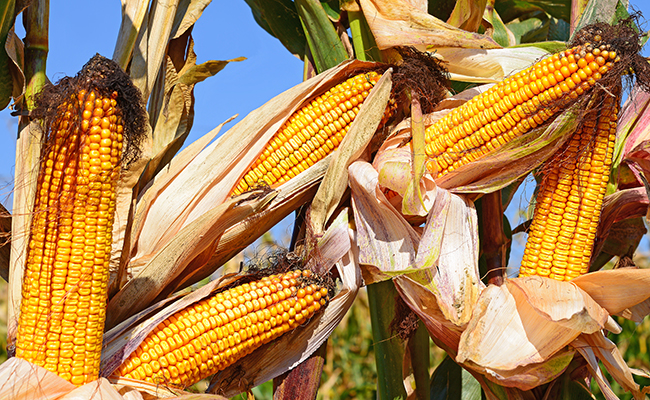
‘Grown-in-India’ corn in trouble?
Shivani Kapoor | The Dollar Business  Why does almost everything that’s talked about as a ‘positive detection’ in biology lead to a ‘negative shift’ in sentiments? Actually, that happens in exports too. Call it a corny coincidence if you will, but one such positive-yet-negative moment for exporters is now. Detection of aflatoxin (a toxin produced by a certain variety of fungus and commonly known to be cancer-causing) by Canadian authorities in corn originating from India is likely to have Indian exporters like a cat on hot bricks. This revelation is also set to send many ‘Grown-in-India’ corn importing nations into a trip of apprehension. [Whether it ends up being just a minor fright for either camp is a good question!] The Canadian Food Inspection Agency (CFIA) has begun detaining corn shipments from India after learning of high levels of aflatoxin in organic livestock feed of the crop. A teaspoonful of biology here. Aflatoxin is known to be carcinogenic for animals and humans. Considered to be a chemical produced by mould fungi, aflatoxin sprouts on turmeric, maize, chilly, ginger and can kill livestock. It is known to be a post-harvest issue and develops when its storage is not handled as per farming and packaging standards. Corn containers from India, if rejected following the aflatoxin contamination, will not only have repercussions on the exporting community but on importers, given that India is a significant exporter of the crop. During FY2014, India’s exports of maize (excluding seeds, that also includes the feed variety; HS Code 100590) stood at over Rs.5,800 crore. Given that the country expects to close FY2015 at just over Rs.4,000 crore, the fungal trick will have many-a-heart sinking in the Indian agricultural and exports community. While the CFIA has cautioned its importers to get the corn shipments coming from India tested for aflatoxin presence, Agricultural and Processed Food Products Export Development Authority (APEDA) has expressed its ignorance about the situation. Making no bones about the development, Dr. A. K. Gupta, Director (BEDF) of APEDA, tells The Dollar Business that, “We have not got any notification regarding any such crackdown from Canada.” When asked about repercussions if valuable consignments from India were to be rejected by the Canadian import authorities, Gupta branded the outcome “a manageable issue”. “If any country rejects a consignment, it is but obvious that exports will get affected. However, aflatoxin contamination is a manageable issue. It is not that a major trouble since we have, in the past, faced similar concerns from Vietnam and we were able to get it resolved,” said Gupta. Is APEDA being economical about the truth? Or maybe, it just laid everything on the line and that was that. Simple home remedies could make all wrongs right for corn exporters. Maybe. India has been a significant exporter of maize to Canada. Of the $182 million-plus of the Corn variety (non-seed) imported by Canada in CY2014, India accounted for almost 5% of the share. But the problem doesn’t end there. In all likelihood, other importing nations will catch the warning flares above the Canadian skies. And that will mean at least $200 million in lost consignment opportunities of the product (that could have been exported), if a ban is imposed for even a quarter of a year (assuming exports to remain stagnant at CY2014 levels, ceteris paribus). B. Jain, Promoter of Sri Padmavati Exports, a Karnataka-based exporter of corn, doesn’t bother to soften the reality. He tells The Dollar Business, “If any export container comes under the scanner, we have to bear the export costs, besides the shipment delays adds to additional expenses incurred by us. Such issues put the image of the entire corn exporting community at stake, irrespective of who is the exporter.” Not that we imagine India having developed antibodies to the ban pathogen, but this is not the first time a question has been raised on Indian agricultural product for non-compliance of standards by exporters. Recently, Vietnam had threatened to ban groundnut imports from India after pests were found in some consignments. Saudi Arabia had also imposed a temporary ban on green chillies from India due to the presence of high levels of pesticides. Following the ban, APEDA advised exporters to adhere to the importing countries’ food safety requirements. Then there was the EU slap last year that made the Alphonso mangoes from India appear notorious! This list is long. India has faced restrictions from import authorities overseas on its agricultural products due to aflatoxin contamination over the years, but it is yet to take any stringent measure to control the contamination. From rice to groundnuts to pepper (black and white), ginger, nutmeg, chilli/chilli products, turmeric, etc. – concerns have been raised but perhaps authorities and agencies like APEDA assume such threats and concerns are only but cases of much ado about nothing. We do have the habit of sweeping even elephants under the carpet. And we do quite well at that. The agricultural products would keep facing such crackdowns in the global market until the concerned agencies in the union we call India come up with improved farm practices and storage techniques to help control pests and contamination. The aflatoxin presence is a storage issue and exporters of agri-products need to ensure that adequate storage standards are maintained. It’s that simple. Problem is – we’re still crying about infrastructure bottlenecks in cold storage after almost seven decades of independence. Here’s a fact that could help policymakers and exporters get some direction. Two-thirds of alerts from foreign authorities have till date been concerning the trouble basket that contains nuts and seeds, vegetables and fruits, and marine products. These are three broad categories. And of the culprits, it is often aflatoxin that plays the devil. [Source: ‘Ensuring Safe Foods and Medical Products Through Stronger Regulatory Systems Abroad’; Committee on Strengthening Core Elements of Regulatory Systems in Developing Countries; Board on Global Health; Board on Health Sciences Policy; Institute of Medicine; page 334; National Academies Press (US); 2012]. Getting the right storage and testing facilities for a few product categories to begin with can be a start. And of course, we continue to hope that wonders will never cease!
Why does almost everything that’s talked about as a ‘positive detection’ in biology lead to a ‘negative shift’ in sentiments? Actually, that happens in exports too. Call it a corny coincidence if you will, but one such positive-yet-negative moment for exporters is now. Detection of aflatoxin (a toxin produced by a certain variety of fungus and commonly known to be cancer-causing) by Canadian authorities in corn originating from India is likely to have Indian exporters like a cat on hot bricks. This revelation is also set to send many ‘Grown-in-India’ corn importing nations into a trip of apprehension. [Whether it ends up being just a minor fright for either camp is a good question!] The Canadian Food Inspection Agency (CFIA) has begun detaining corn shipments from India after learning of high levels of aflatoxin in organic livestock feed of the crop. A teaspoonful of biology here. Aflatoxin is known to be carcinogenic for animals and humans. Considered to be a chemical produced by mould fungi, aflatoxin sprouts on turmeric, maize, chilly, ginger and can kill livestock. It is known to be a post-harvest issue and develops when its storage is not handled as per farming and packaging standards. Corn containers from India, if rejected following the aflatoxin contamination, will not only have repercussions on the exporting community but on importers, given that India is a significant exporter of the crop. During FY2014, India’s exports of maize (excluding seeds, that also includes the feed variety; HS Code 100590) stood at over Rs.5,800 crore. Given that the country expects to close FY2015 at just over Rs.4,000 crore, the fungal trick will have many-a-heart sinking in the Indian agricultural and exports community. While the CFIA has cautioned its importers to get the corn shipments coming from India tested for aflatoxin presence, Agricultural and Processed Food Products Export Development Authority (APEDA) has expressed its ignorance about the situation. Making no bones about the development, Dr. A. K. Gupta, Director (BEDF) of APEDA, tells The Dollar Business that, “We have not got any notification regarding any such crackdown from Canada.” When asked about repercussions if valuable consignments from India were to be rejected by the Canadian import authorities, Gupta branded the outcome “a manageable issue”. “If any country rejects a consignment, it is but obvious that exports will get affected. However, aflatoxin contamination is a manageable issue. It is not that a major trouble since we have, in the past, faced similar concerns from Vietnam and we were able to get it resolved,” said Gupta. Is APEDA being economical about the truth? Or maybe, it just laid everything on the line and that was that. Simple home remedies could make all wrongs right for corn exporters. Maybe. India has been a significant exporter of maize to Canada. Of the $182 million-plus of the Corn variety (non-seed) imported by Canada in CY2014, India accounted for almost 5% of the share. But the problem doesn’t end there. In all likelihood, other importing nations will catch the warning flares above the Canadian skies. And that will mean at least $200 million in lost consignment opportunities of the product (that could have been exported), if a ban is imposed for even a quarter of a year (assuming exports to remain stagnant at CY2014 levels, ceteris paribus). B. Jain, Promoter of Sri Padmavati Exports, a Karnataka-based exporter of corn, doesn’t bother to soften the reality. He tells The Dollar Business, “If any export container comes under the scanner, we have to bear the export costs, besides the shipment delays adds to additional expenses incurred by us. Such issues put the image of the entire corn exporting community at stake, irrespective of who is the exporter.” Not that we imagine India having developed antibodies to the ban pathogen, but this is not the first time a question has been raised on Indian agricultural product for non-compliance of standards by exporters. Recently, Vietnam had threatened to ban groundnut imports from India after pests were found in some consignments. Saudi Arabia had also imposed a temporary ban on green chillies from India due to the presence of high levels of pesticides. Following the ban, APEDA advised exporters to adhere to the importing countries’ food safety requirements. Then there was the EU slap last year that made the Alphonso mangoes from India appear notorious! This list is long. India has faced restrictions from import authorities overseas on its agricultural products due to aflatoxin contamination over the years, but it is yet to take any stringent measure to control the contamination. From rice to groundnuts to pepper (black and white), ginger, nutmeg, chilli/chilli products, turmeric, etc. – concerns have been raised but perhaps authorities and agencies like APEDA assume such threats and concerns are only but cases of much ado about nothing. We do have the habit of sweeping even elephants under the carpet. And we do quite well at that. The agricultural products would keep facing such crackdowns in the global market until the concerned agencies in the union we call India come up with improved farm practices and storage techniques to help control pests and contamination. The aflatoxin presence is a storage issue and exporters of agri-products need to ensure that adequate storage standards are maintained. It’s that simple. Problem is – we’re still crying about infrastructure bottlenecks in cold storage after almost seven decades of independence. Here’s a fact that could help policymakers and exporters get some direction. Two-thirds of alerts from foreign authorities have till date been concerning the trouble basket that contains nuts and seeds, vegetables and fruits, and marine products. These are three broad categories. And of the culprits, it is often aflatoxin that plays the devil. [Source: ‘Ensuring Safe Foods and Medical Products Through Stronger Regulatory Systems Abroad’; Committee on Strengthening Core Elements of Regulatory Systems in Developing Countries; Board on Global Health; Board on Health Sciences Policy; Institute of Medicine; page 334; National Academies Press (US); 2012]. Getting the right storage and testing facilities for a few product categories to begin with can be a start. And of course, we continue to hope that wonders will never cease!
May 27, 2015 | 7:47 pm IST.






 to success.
to success.